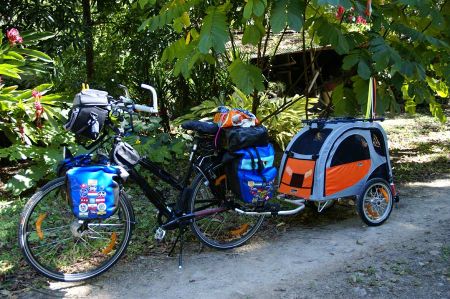Holidays with your dog - How to properly ride a bike
- Written by Portal Editor
As relative newcomers on a section of the Main Cycle Path, we were quite astonished when we met Rita, who spent her short break this time with bicycle, panniers, tent and .... dog during a short break between Dettelbach and Volkach.
Our question about where from she answered with Bamberg. And since we are also "dog owners" ourselves, the question was obvious: Such a long tour with a dog? It is working? And we were already talking.
Almost as if Rita wanted to reveal something secret
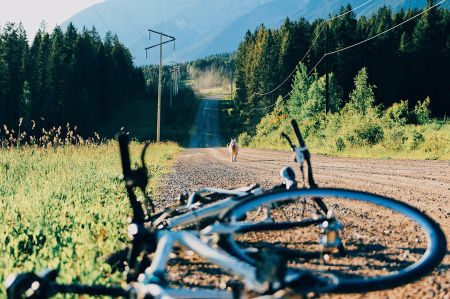 She is single and likes to be outside, preferably on her bike, Rita continues, and since the Munsterland crossbreed constantly needs exercise, it was obvious to combine a short weekend break and a holiday with the dog. A little unusual at first, today the two form an inseparable team that is out and about somewhere on the bike slopes almost every weekend. Hotels and guesthouses are sometimes not prepared for guests with dogs, so weekend bike tours often take place with tents and air mattresses. At least in summer.
She is single and likes to be outside, preferably on her bike, Rita continues, and since the Munsterland crossbreed constantly needs exercise, it was obvious to combine a short weekend break and a holiday with the dog. A little unusual at first, today the two form an inseparable team that is out and about somewhere on the bike slopes almost every weekend. Hotels and guesthouses are sometimes not prepared for guests with dogs, so weekend bike tours often take place with tents and air mattresses. At least in summer.
Of course, we are interested, because how do you get the dog to move safely parallel to the bike over a long distance, especially a Munsterlander mix that usually chases after anything interesting. A smile appears, almost as if Rita wanted to reveal something secret, but all she got was: Start slowly!
Rita proceeded very pragmatically by slowly getting the dog used to the bike. During the daily walk, she took the bike with her and initially pushed it. On small downhill passages she then sat down on the bike seat from time to time and just let it roll. The dog's shyness in front of the monster, which sometimes produces strange noises, slowly disappeared, finally Mistress gave him a treat from time to time.... and the monster went away empty-handed.
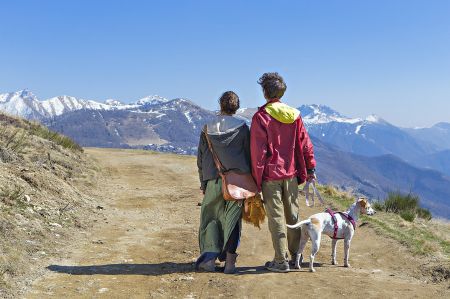 The Munsterlander got used to the bike more and more and the first short distances were already possible. Sometimes for shopping, sometimes just around the block, anticipation could be seen in their eyes when it was finally time to go outside again. As soon as the dog pulls on the leash, stand still until he returns to the correct position next to the wheel, Rita says. Even if this method is tedious - this is the only way for the dog to notice that it is not going faster by pulling but, on the contrary, rather more slowly. The four-legged friend should walk at about the level of your calves.
The Munsterlander got used to the bike more and more and the first short distances were already possible. Sometimes for shopping, sometimes just around the block, anticipation could be seen in their eyes when it was finally time to go outside again. As soon as the dog pulls on the leash, stand still until he returns to the correct position next to the wheel, Rita says. Even if this method is tedious - this is the only way for the dog to notice that it is not going faster by pulling but, on the contrary, rather more slowly. The four-legged friend should walk at about the level of your calves.
The tours were slowly increased from 20 to 30 minutes, then to an hour. It's important not to rush into it. Dogs, what a similarity to humans, like to overestimate themselves and can therefore easily overexert themselves if the drive is too fast. Because dogs also have to build up their condition with regular training, just like us humans.
If it doesn't work at all anymore, and now her gaze shifts in the direction of the bicycle trailer, I'll move my luggage a bit to the side so that there is room for the dog, although he doesn't like it at all.
.... do not prevent contact with conspecifics
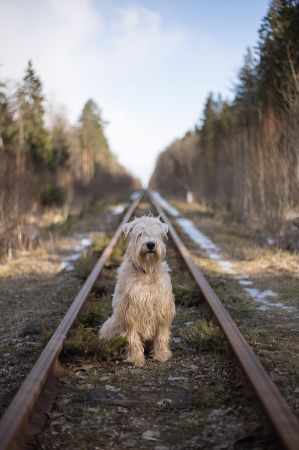 The duration of the cycle tour depends on the condition of the dog, rarely a question of breed, although, according to Rita, the dog should not be too small or too big. Being mature is important. From the age of one and a half to two years, the skeleton is fully developed and sufficiently hardened. Of course, sick or old dogs or dogs with joint problems are also not suitable companions when cycling on a short vacation on the Main Cycle Path. Which, according to Rita, would be ideal for a holiday with a dog, since it is usually far away from the noise of the streets and wide enough for oncoming cyclists to pass easily.
The duration of the cycle tour depends on the condition of the dog, rarely a question of breed, although, according to Rita, the dog should not be too small or too big. Being mature is important. From the age of one and a half to two years, the skeleton is fully developed and sufficiently hardened. Of course, sick or old dogs or dogs with joint problems are also not suitable companions when cycling on a short vacation on the Main Cycle Path. Which, according to Rita, would be ideal for a holiday with a dog, since it is usually far away from the noise of the streets and wide enough for oncoming cyclists to pass easily.
Which brings us to the next topic. Because, Rita continues, you also have to make sure that the dog gets enough variety on the go. Sometimes slowly, sometimes a sprint. Sometimes the little dog should sniff, then do his business and above all, .... not prevent contact with conspecifics.
It can be dangerous in traffic if your dog suddenly pulls on the leash, so never attach the dog's leash to the bicycle handlebars. This way you both end up in danger if something does happen. At the beginning, therefore, praise your dog's correct behaviour extensively. Of course, you can also train your dog to run freely alongside you, but never in traffic. There would be no liability insurance that would occur in such a case of damage.
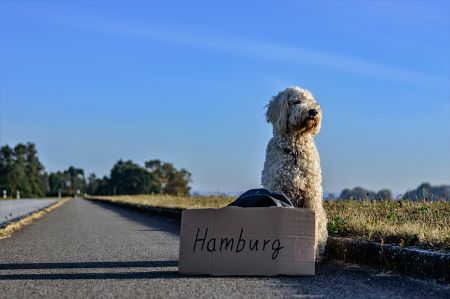 At the beginning, asphalted paths were a problem, since the hard surface made things difficult for the joints. Rita therefore always keeps an eye on the surface of the paths, because grit in particular acts like sandpaper on the paws. Also, hardly a problem on the Main cycle path, because the green strips are usually very short, so that the dog can walk very well there. Whenever possible, however, Rita chooses forest and dirt roads as intermediate passages. And for the care of the dog's paws, Rita has the tried and tested milking grease ready, which is also excellent for delicate hands.
At the beginning, asphalted paths were a problem, since the hard surface made things difficult for the joints. Rita therefore always keeps an eye on the surface of the paths, because grit in particular acts like sandpaper on the paws. Also, hardly a problem on the Main cycle path, because the green strips are usually very short, so that the dog can walk very well there. Whenever possible, however, Rita chooses forest and dirt roads as intermediate passages. And for the care of the dog's paws, Rita has the tried and tested milking grease ready, which is also excellent for delicate hands.
So, there's really nothing wrong with vacationing with your dog, whether on the Main Cycle Path or somewhere in the woods. It should bring fun and joy to both of them, that's important. And with joy comes peace and serenity, so that you don't necessarily have to worry about liability insurance for your dog.
Please read as well:
